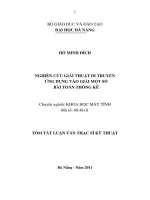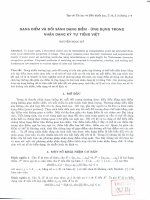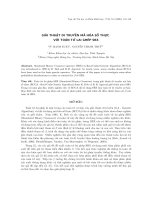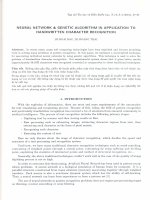Mạng nơ ron và giải thuật di truyền ứng dụng cho nhận dạng ký tự viết tay. pot
Bạn đang xem bản rút gọn của tài liệu. Xem và tải ngay bản đầy đủ của tài liệu tại đây (4.77 MB, 9 trang )
T,!-p chf
Tin hoc
va
Di'eu
khie'n h<;JC,T.17, S.4 (2001),
57-65
NEURAL NETWORK
&
GENETIC ALGORITHM IN APPLICATION TO
HANDWRITTEN CHARACTER RECOGNITION
LE HOAI BAC, LE HOANG THAI
Abstract. In recent years, many soft computing technologies have been exploited and become promising
tools in solving many problems of pattern recognition. In this paper, we represent a novel hybrid technique
for associating individual neural networks by using genetic algorithms. This technique is used to solve the
problem of handwritten character recognition. Our experimental system shows that it gives better results
(approximately
98.53%
characters were recognized correctly) in comparation to other traditional techniques.
T6m tJ{t.
Nhirng
nam g~n day, nhieu ky thuat phan mern may tfnh timg dtro'c khai thac va tr& thanh cac
cong cVhtra hen
irng
dung cho bai toan nhan dang mh.
Trong pham vi bai bao, chung toi trlnh bay mqt ky thu%t lai:
suo
dung thu%t gi<iidi truyen dg lien klh cac
mang no-ron ca the'. H~ thOng xay du-ngtir ky thu%tnay dtro'c trng dung de' gidi quyet bai toan nhan dang
ki tV"viet tay.
Cac ket qua thu: nghiem cho tHy h~ thong thu diro'c
nhirng
ket qua v&itll~ nhan dang cao
(98,53%)
tot
ho-nso vo'i cac phtro'ng phap
cCS
truysn khac.
1. INTRODUCTION
With the explosion of information, there are more and more requirements of the automation
for text translating and recognizing process. Because of this, today, the field of pattern recognition
and particularly handwritten recognition has received a lot of attention from research community in
artificial intelligence. The process of text recognition includes the following primary stages:
- Digitizing text by scanner and then storing results in files.
- Raw processing such as enhancing images, extracting character regions from text, then
extracting each character in the form of pixel matrix.
- Recognizing each character.
- Restoring the content of text.
Here we only discuss about the stage of character recognition, which decides the speed and
exactness of a text processing and recognition system.
Until now, we have many traditional character recognition techniques such as mask matching,
contrasting of weighted points through a central point, contrasting by using splitting and dividing
point, exploiting the statistics of intersected points and method of structural recognition, etc
Generally, the above traditional techniques couldn't work well in the case of the quality of image
digitizing process is not so high.
In order to overcome this shortcoming,
Artificial Neural Network
has been used in pattern recog-
nition problems. A neural network is a biological simulation of human brain by computer. It is a
parallel structure constructed from many elements (neurons) associating together through weighted
numbers. Each neuron is also a non-linear dynamic system which has the ability of self-learning.
Thus, a neural network can learn from experiences or from a pattern set
[31.
The use of neural networks in pattern recognition problems does not require pre-processing stages
as thinning, contour smoothing or noise filtering.
58
LE HOAI BAC, LE HOANG THAI
Recently, the combination of multiple neural networks through flexible computing tools has been
referred as a new way to construct pattern recognition problem-solving systems with high efficiency
[4,7]. While normal techniques select the best network from the attendant ones, this associating
technique will keep all individual networks and apply an appropriate common set decision strategy.
In this paper, we propose a novel method using
Genetic Algorithm
in
Associating Individual
Neural Networks.
They not only consider the differences in performance of each network during
association, but also use weighted numbers (evaluating the reliability of each individual network).
The genetic algorithm will define the values of these weighted numbers, and associate individual
networks to obtain a suitable output result.
By comparing with traditional techniques through experiments in handwritten recognition prob-
lem, our method proves its pre-eminent quality.
The following section will discuss in detail about the problem and possible methods to associate
individual neural networks.
Section 3 represents our method of
Associating Individual Neural Networks
based on
Genetic
Algorithm.
Section 4 shows experimental results in applying the proposed method to recognize handwritten
characters (for vowels
a, e,
i,
0,
u).
Section 5 concludes this paper.
2. THE METHODS FOR ASSOCIATING MULTIPLE NEURAL NETWORKS
A feedforward neural network is considered as a mapping means between the sets of input and
output values. It plays a role of a function
f
that maps the input set
I
into the output set 0, i.e.
f :
1-+0
or
Y =
f(x),
where
Y
E 0 and
x
E
I.
Since the problem of classification is actually a map
from the space of characteristic vectors into the set of output classes, we consider neural networks
as a classifier (in particular the two-layer feedforward neural network is trained by the general delta
learning rule).
Given a classifier - a two layer neural network with
T
neurons in input layer,
H
neurons in
hidden layer, and c neurons in output layer. Here
T
is the dimension of characteristic vectors, c
is the number of pattern classes, and
H
is a properly selected number. The network will associate
completely adjacent layers and its activities can be understood as a nonlinear process: input a pattern
X
=
(Xl,
X2, , XT)
(its class is still unknown) and the set of classes 11
=
{WI, W2, , We};
then each
output neuron will produce
y
belonging to one of these classes, which is defined by
H T }
P(Wi IX) ~ Yi
=
f { {;
wik'
f (~
w;;;.i
Xi) .
(1)
In the expression (1),
w~.i
is the weighted number between the
ph
input neuron and the
kth
hidden neuron,
wik'
is a weighted number between the
kth
hidden neuron and
ith
output class, and
f
is sigmoid function which is defined by
f(x)
= __
1_. The indexes
i,
m,
0
in weighted numbers
1
+
eX
are used to show that those numbers belong to input class, hidden class, or output class of the neural
network. The decision object will belong to the class which has maximum neuron.
The above-mentioned network is trained on the set of experimental patterns and discovers re-
lationships that help to distinguish the patterns. However, a limited size network will not give high
efficiency in mapping process. The increase of size and number of hidden classes doesn't provide con-
siderable improvements. Furthermore, in complex problems, for instance, the problem of handwritten
recognition, the number of both characteristics and classes is very large.
The main idea in the strategy of using simultaneously multiple networks is constructing n inde-
pendent networks trained with correspondent characteristics, and applying the method of associating
NEURAL NETWORK
&
GENETIC ALGORITHM FOR HANDWRITTEN CHARACTER RECOGNITION 59
networks to give decisions in general classification. Figure 1 shows the schema of associating mul-
tiple networks. The associator will combine results from trained individual networks with different
characteristics. Therefore, the problem is how to synthesize results from each individual network (or
could be called expert)?
<Il
·c
0-
x
•• Q
<J ••
'" <J
'"
0-
'"
.c ••
y
<J ~
••
.c
0-
f-<
Fig.
1. The method of associating individual neural networks
There are two general methods for associating neural networks: the first one
based on unifying
technique,
and the second one
based on selection technique.
With the
unifying technique,
the classification of an input pattern X is based on the set of real
values measured by:
P(Wi
I
X),
1::;
i ::;
c.
(2)
They will compute the probability of the event "X belongs to one of c original classes". In
associating scheme including
n
networks, each
kth
network will be evaluated by the set of probability
values:
(3)
A simple method to associate results on the same pattern X from all
n
individual networks is
using the following average value as a new way to evaluate associated networks:
1 n
P(Wi
I
X) = -
2:
Pk(Wi
I
X), 1::;
i ::;
c.
n
k=l
(4)
Thus, the above associating value can be considered as an average classification of Bayes method
[7]. This evaluation will be improved if we add the ability of direction for outputs based on knowledge
60
LE HOAI BAC, LE HOANG THAI
about the reliability of each network:
n
P
(Wi
I
X)
=
L
r~
P
k
(Wi
I
X) ,
1:0::::
i
:0::::
c,
k=l
(5)
where
n
L
r~
=
l.
k=l
(6)
From another point of view, the selection technique considers results of each network as the
decision of an expert. Many selection techniques have been created and based on the theory of group
decision forming, such as unanimity, Borda count etc (see details in [8]).
3. THE GENETIC ALGORITHM FOR COMBINING INDIVIDUAL
NEURAL NETWORKS
This section will introduce generally about Genetic Algorithm (GA) and the application of GA
to associate individual neural networks.
3.1. Fundamentals about genetic algorithm (GA)
[61
Until now, in the research and application of informatics, there have been many interesting
problems without fast and appropriate solving methods appeared. The most part in those problems
are optimal ones existed in applications. In order to solve this kind of problems, it is often necessary
to find an efficient algorithm. However the results are just nearly optimal. A genetic algorithm (GA)
is one of those tools.
The following scheme shows general structure of
a
genetic algorithm:
Procedure G
A;
Begin
t
:=
0;
Initializing class
P(
t);
Evaluating class
P(t);
While
not End_Condition
do
Begin
t:=t+l;
Select
P(t)
from
P(t-l);
Reconstruc ting
P(
t);
Evaluating
P(t);
End
End.
The basic operations of genetic algorithm for
a
particular problem include:
*
Representing genetic with potential solutions of the problem;
*
Creating the population of original solution;
*
Constructing evaluating function;
*
Defining genetic operators;
*
Defining parameters used by a genetic algorithm.
3.2. Applying genetic algorithm (GA) in associating neural networks
In computing process, the genetic algorithm maps the solution space of the problem into the set
of strings, each string represents a potential solution.
NEURAL NETWORK
&
GENETIC ALGORITHM FOR HANDWRITTEN CHARACTER RECOGNITION 61
In our problem, each string has to encode
n
X c real value parameters
(r/)
in the expression (5),
by this we can obtain optimal associating factors for combining individual neural networks. Each
factor will be encoded into 8 bit and modified in the interval [0,1]. After that, GA operates over
encoded strings to find better solutions corresponding to each generation.
The operation cycle of GA includes:
1. Creating the population of real value encoded strings.
2. Evaluating each string with fitness function defined as recognition ratio correspond to training
data set.
3. Selecting good strings (has maximum fitness value).
4. Using genetic crossovers and mutation operators to create new populations of strings.
This cycle stops when recognition ratio gains best possible level.
Note: All individuals belonging to the old population will be replaced by the new ones. The
storage of the best potential solutions will help obtain the advancement after each generation [2].
Figure 2(a) depicts four stages in applying biological genetic technique. GA method proposes to
take the set of factors
(r/)
of individual neural networks to form correspondent encoded strings, as
shown in Figure 2(b).
Fig.
2(a).
The basic steps of a genetic algorithm
Populations (Chromosomes)
Fig.2(b).
The algorithmic schema of the proposed method
62
LE HOAI BAC, LE HOANG THAI
4. THE APPLICATION IN RECOGNIZING HANDWRITTEN
VOWEL CHARACTERS
The above system was implemented by using Borland C language in a Pentium III PC 766 Mhz.
This experiment was carried with 13 people. Each one wrote 50 times, each time they wrote 5 vowel
characters
(a, e,
i,
0,
u).
Thus the number of experimental characters are: 13
X
50
X
5
=
3250. In
those characters, 2500 characters were used for training and 750 characters were tested. Figure 3(a)
and Figure 3(b) depict the sets of training patterns and testing patterns used in this experiment,
respectively.
(LeIO~
CLe\OUv
«
e
t
o
u
~~ / \) U
a e
IOU
Fig. S(a).
Vowel patterns used for training
Fig.
S(b).
Vowel patterns used for testing
4.1. Extracting characteristics
Each character, in handwritten or typewriting format, has to draw fundamental lines. Therefore
the seeking of local strokes becomes a suitable method to extract characteristics. With each position in
image, the information represents a stroke in a given direction will be saved in a characteristic vector
[5]. Especially in this paper, Kirsch masks [1] have been used for extracting direction characteristics.
Kirsch defined non-linear algorithm to detect boundary as follows:
G(i,
j)
=
max { 1,
T~6'[158k - 3Tkl]},
(7)
where
8k
=
Ak
+
Ak+
1
+
Ak+2,
Tk = Ak+3
+
Ak+4
+
Ak+S
+
Ak+6
+
Ak+7.
(8)
(9)
Here
G(i,
j)
is
gradient
of pixel
(i,
j),
a boundary
A
has the length of 8, and
Ak
(k
=
0,1,2, ,7)
are
8
neighbors of pixel
(i,
j)
as showed in Figure 4.
-
Ao Al
A2
A7
(i,
j)
A3
A6 As
A4
Fig.
4.
8 neighbors
Ak
(k
=
0,2, ,7) of pixel
(i,
j)
Firstly, the data set will be pre-processed. After that each vowel will be divided into sub-regions
with sizes 16
X
16 to preserve directions of the image. Then characteristic vectors for horizontal
direction, vertical direction, right-diagonal direction, and left-diagonal direction will be formed from
the divided image [1].
Gv
(i,
j)
=
max (1582 -
3T21,
1586-
3T61),
GH(i,
j)
=
max(158
0
-
3Tol,
158
4
-
3T
4
1),
Gdi,
j)
=
max(158
3
-
3T31,
158
7
-
3T
7
1),
NEURAL NETWORK
&
GENETIC ALGORITHM FOR HANDWRITTEN CHARACTER RECOGNITION 63
GR(i,
j)
=
max(158
1 -
3T
1
I,
158
s
- 3T
s
l)·
The final step in extracting characteristics is using median operators to compress directed vectors
with size of 16
X
16 to vectors with size of 4
X
4, these operators produce a value for 2
X
2 pixel by
summing 4 values on 2 x 2
=
4 pixels divided by 4.
Besides that, the
8
X
8
reduced
normalized image
plays a role of a global characteristic.
At this point we also exploit a boundary characteristic. After extracting boundary from a
normalized size image (8
X
8 image), we obtain boundary characteristics representing directions for
a vowel pattern.
Thus in the final result, the characteristics used include: four 4x 4 local characteristics, one global
characteristic:
8
X
8
normalized image,
and characteristics have structures which were extracted from
boundary of vowel characters.
4.2. The application of associating method
In order to evaluate the ability of associating individual networks, we conducted our experi-
ments with three two-layer networks. Each network uses different characteristic tuples.
N
Nl is
used with Kirsch characteristics,
N N2
with
normalized image,
and
N N3
with the series of boundary
characteristics.
By exploiting this method, each network will form a decision through its own standard. That
means, after being trained with each characteristic tuple, each
N N
is possible to give out its own class
division (Each
N N
will appreciate the belonging of the received pattern in comparation to vowels
a,
e,
i,
0,
u).
Each network will be trained with 2500 vowel patterns and tested over 750 vowel patterns.
We use back-propagation algorithm [2] for the training with the iteration of computing process
continuing to the point where squared mean error less than 0.9 (corresponding to the set of training
pattern), or when the number of iterative times equals to 1000 (the limit point of networks during
training). The parameters used for training are learning factors (equals to 0.1) and an input vector
which is decided to belong to a class based on maximum output value, respectively.
After training three networks with separate characteristics, we use GA to find optimal parameters
for associating networks. Our original population has 100 individuals, and each contains 120 bit
(3
X
5
X
8).
The evolutionary parameters are used for this experiment in the following way: crossover
probability at one point is 0.6, and mutation probability equals to 0.01 (1%).
The fitness value Res[i] (i
=
1, ,numclass, numclass is the number of class, in this case, it equals
to the quantity of vowel patterns, numclass
=
5) is assigned to a string by testing the recognition
ratio with trained vowel patterns.
In details, assumed that the output of each network is output[k][i]
(k
=
1, ,
n, n
equals to the
quantity of
N N.
In our problem, take, for example,
n
=
3, i
=
1, , numclass). Applying genetic
algorithm over encoded string of Combiner to obtain the best recognition ratio on training pattern
set with the following constraint:
n
Res[i]
=
2:)Combiner[k][i]
*
Output[k][i]), i
=
1 , NumClass.
k=l
Here, combiner is the set of neural network associating factors, where Combiner[k][i] is the factor
(weighted number) of ith output of kth network.
If Res[i] is maximum, the object is decided to belong to class i.
(This applying expression is equivalent to the expression (5) in the second section.)
The cycle of evolutionary processing stops when the best fitness value of the population couldn't
be improved any more in the next loops.
64
LE HOAI BAC, LE HOANG THAI
Through experiments, we observe that the efficiency increases gradually over generations and
after original basic improvements the global fitness value will rapidly gain the convergent value
(around 150 loops).
4.3. The experimental results
With the proposed method, we obtain the following result:
The number of tested vowel patterns The number of error vowels The recognition rate
750
11
98.53%
By applying the method of computing averages to associate three networks, we have:
The number of tested vowel patterns The number of error vowels The recognition rate
750 31 95.87%
By applying a neural network for recognizing the above vowel set, we obtain the following result:
The number of tested vowel patterns
The number of error vowels The recognition rate
750 59 92.13%
From the above results, we can observe that our proposed method provides better results than
applying the method of computing average or the method of using single neural network. In practice,
the proposed method has exploited the advantages of recognition ratio obtained from normal methods
(single neural network). We can conclude that the method of associating individual neural networks
in the problem of handwritten vowel recognition is executable and ensure to obtain high recognition
ratios.
5. CONCLUSION
This paper represented the method of applying a genetic algorithm in associating individual
neural networks to construct a performance-improved system in the problem of pattern recognition
and particularly in handwritten vowel recognition. The experimental results show that this method
obtains considerable improvements. This easy-to-understand and easy-to-conduct computing method
will power dramatically the field of pattern recognition. The main contribution of this paper is point-
ing out the potential of hybrid computing technology in applying to the problem of pattern recogni-
tion. Besides that, the proposed method also provides important improvements seeking solutions for
a variety of problems.
However, all the above results are only the experimental ones at the beginning stage.
We hope that in the near future, we can declare the better results to justify clearly the reliability
of the method represented in the paper.
REFERENCES
[1] Anil K. Jain,
Fundamentals of Digital Image Processing,
Prentice Hall, 1986.
[2] Chin - TengLin and C. S. George Lee,
Neural- Fuzzy Systems: A Neuro - Fuzzy synergism to
Intelligent Systems,
Prentice - Hall International, Inc, 1996.
[3] Hoang Kiem, Le Hoai Bac, and Le Hoang Thai, A fuzzy neural network for Vietnamese character
recognition,
Proceeding of ICIP'99, International Conference on Image Processing,
IEEE Signal
Processing Society, JAPAN, 1999.
[4] J. A. Benediktsson and P. H. Swain, Consensus theoretic classification methods,
IEEE Trans.
On System and Man Cybernet.
22 (1992) 418-435.
NEURAL NETWORK
&
GENETIC ALGORITHM FOR HANDWRITTEN CHARACTER RECOGNITION 65
[5) Knerr L. Personnaz, and G. Drayfus, Handwritten digit recognition by neural networks with
single-layer training,
IEEE Trans. On Neural Networks
3 (6) (1992) 962-968.
[6) Nguyen Thanh Thuy and Le Hoang Thai, Genetic algorithm: technique and its application in
data analysis,
Journal of Computer Science and Cybernetics
15
(1) 1999.
[7) S B. Cho and
J.
H. Kim, Combining multiple neural networks by fuzzy integral for robust
classification,
IEEE Trans. On System and Man Cybernet.
25
(1995) 380-384.
[8) T. K. Ho, "A theory of multiple classifier systems and its application to visual word recognition",
Ph.D Disertation, University of Buffalo, 1992.
Received June
12,
2001
Revised August 20, 2001
Department of Information Technology,
University of Natural Sciences, Ho Chi Minh City.









